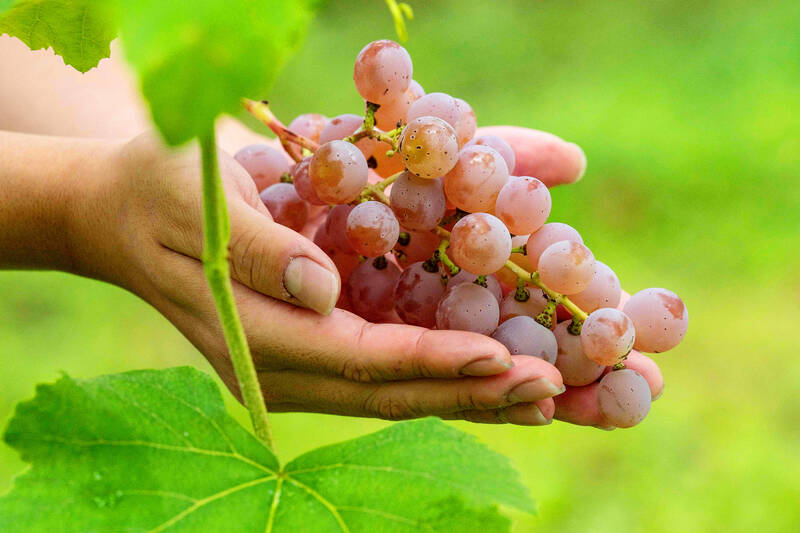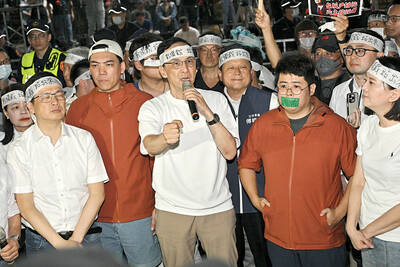Japanese food is famously paired with sake, but winemakers near Mount Fuji are on a mission to prove their bottles go just as well with crispy tempura and delicately sliced raw fish.
With its abundant rain and formidable summer humidity, Japan is far from ideal wine terroir, so producers have fine-tuned their craft to adapt to the challenges of the climate.
The result is an acclaimed wine called koshu: a light, dry white designed to complement the subtle flavors of Japanese cuisine that has scooped international awards.

Photo: AFP
Koshu has been produced in the mountainous region of Yamanashi since the first commercial vineyards were established there in the 1870s.
The thick-skinned grape variety grown for centuries in Yamanashi was seen as a hardy choice by early winemakers, who learned their techniques in France.
But the results were mediocre, even until two decades ago.

Photo: AFP
“We used to say koshu was not good for wine, or for eating — that it had no taste, no flavor, no colour,” said Takayuki Tamura of Chateau Mercian, one of Yamanashi’s largest wine producers.
Tamura, Mercian’s chief winemaker in the region, said the turning point for Koshu came in 2003, when a team of Japanese and French researchers from the University of Bordeaux discovered citrus notes in fermentation tests.
That “led to a re-think of agriculture methods and vinification techniques” to draw out these aromas, he explained.
Since then, winemakers in Yamanashi have invested heavily in koshu production, and it has paid off.
Two koshu vintages from the region’s wineries won the second-place platinum medal at the Decanter World Wine Awards, the world’s largest wine competition.
GRAPE ‘UMBRELLAS’
One of those award-winners was L’Orient Shirayuri Winery, a small family vineyard established in 1938, where workers inspect the dusky lilac grapes on their pergola under a low, stormy sky.
Growing on the structures “reduces the grapes’ exposure to humidity, and helps them dry in the wind,” said Keiya Uchida, general manager at Shirayuri.
To protect the fruit from the rain, each bunch is given a small umbrella-like hat made from a white material with a waxy surface.
“Foreign visitors often find that a bit mad” because of the time spent to attach the umbrellas, said the 28-year-old, who studied viticulture in France’s Burgundy.
But it’s an “essential” measure, as frequent downpours and high humidity “makes grapes fragile and prone to disease.”
Such efforts have transformed the fertile soils of Yamanashi, near Japan’s most famous peak, into the country’s premier wine region.
Around 90 producers compete to supply a burgeoning market for local wine, with many vineyards squeezed into rural corridors between built-up areas.
Imported wine, mainly from France, Chile and Italy, still makes up around two-thirds of the domestic market by volume, with prices ranging from cheap mass-produced plonk to eye-wateringly expensive vintages.
Most of the rest is produced in Japan, but using grapes from elsewhere.
However, in 2018, a special label was introduced to distinguish wine grown in the country, with the average price for a bottle around 2,000 to 3,000 yen (US$13 to US$20).
‘RENEWED INTEREST’
Such “made-in-Japan” wine accounts for around five percent of the market, a share that is slowly increasing.
That could grow to 10 percent within five or six years thanks to the improving quality of koshu, said Mitsuhiro Anzo, director general at Chateau Mercian and president of the Yamanashi Prefecture Wine Manufacturers’ Association.
Marie Ishiyama, a 30-year-old Tokyo resident tasting the wines at Shirayuri, also believes demand is rising.
“Although foreign products are very popular, there’s a renewed interest for local, made-in-Japan products,” including wine, she said.
Japan still sells very little wine abroad, with exports in 2021 worth 687 million yen (then US$6.2 million) — compared with 46 billion yen (US$420 million) for whisky and 40 billion yen for sake, its famous rice wine.
High labor costs, obstacles posed by Japan’s climate and limited farmland mean the nation will never produce and export wine at large volumes, said Frederic Cayuela, an instructor at Academie du Vin, a wine academy in Tokyo.
“So they have this really big focus on the quality rather than the quantity,” he said.
Japan’s wine industry can grow a niche appeal by focusing on its unique tastes and how well the wine accompanies Japanese or fusion food, he said.
Anzo from Chateau Mercian, which is owned by drinks giant Kirin and picked up a gold medal for a koshu wine at the 2021 International Wine Challenge, is on the same wavelength.
“Twenty years ago, we were only trying to imitate foreign wine. But now, we have very specific varieties, like koshu,” he said.
“Many overseas consumers are interested in Japanese culture and cuisine, which is a good thing for Japanese wine.”

April 28 to May 4 During the Japanese colonial era, a city’s “first” high school typically served Japanese students, while Taiwanese attended the “second” high school. Only in Taichung was this reversed. That’s because when Taichung First High School opened its doors on May 1, 1915 to serve Taiwanese students who were previously barred from secondary education, it was the only high school in town. Former principal Hideo Azukisawa threatened to quit when the government in 1922 attempted to transfer the “first” designation to a new local high school for Japanese students, leading to this unusual situation. Prior to the Taichung First

Chinese Nationalist Party (KMT) Chairman Eric Chu (朱立倫) hatched a bold plan to charge forward and seize the initiative when he held a protest in front of the Taipei City Prosecutors’ Office. Though risky, because illegal, its success would help tackle at least six problems facing both himself and the KMT. What he did not see coming was Taipei Mayor Chiang Wan-an (將萬安) tripping him up out of the gate. In spite of Chu being the most consequential and successful KMT chairman since the early 2010s — arguably saving the party from financial ruin and restoring its electoral viability —

The Ministry of Education last month proposed a nationwide ban on mobile devices in schools, aiming to curb concerns over student phone addiction. Under the revised regulation, which will take effect in August, teachers and schools will be required to collect mobile devices — including phones, laptops and wearables devices — for safekeeping during school hours, unless they are being used for educational purposes. For Chang Fong-ching (張鳳琴), the ban will have a positive impact. “It’s a good move,” says the professor in the department of

Toward the outside edge of Taichung City, in Wufeng District (霧峰去), sits a sprawling collection of single-story buildings with tiled roofs belonging to the Wufeng Lin (霧峰林家) family, who rose to prominence through success in military, commercial, and artistic endeavors in the 19th century. Most of these buildings have brick walls and tiled roofs in the traditional reddish-brown color, but in the middle is one incongruous property with bright white walls and a black tiled roof: Yipu Garden (頤圃). Purists may scoff at the Japanese-style exterior and its radical departure from the Fujianese architectural style of the surrounding buildings. However, the property